Ticks & Lyme Disease - A Guide for Preventing Lyme Disease
What Is Lyme Disease?
Lyme disease is a bacterial infection caused by the bite of an infected deer tick. Untreated, the disease can cause a number of health problems. Patients treated with antibiotics in the early stage of the infection usually recover rapidly and completely.
Where Is Lyme Disease Found?
In the United States, infected ticks can be found in the Northeast, including New York State; in the upper Midwest; and along the Northwest coast.
What Are the Symptoms of Lyme Disease?
The early symptoms of Lyme disease may be mild and easily missed. If you find a tick attached to your skin, remove the tick with tweezers (see tick removal instructions on page 6), and watch for the symptoms of Lyme disease. In 60-80% of cases the first symptom is a rash, known as erythema migrans, that:
- Occurs at or near the site of the tick bite.
- Is a "bulls-eye" circular patch or solid red patch that grows larger.
- Appears between three days and one month after the tick bite.
- Has a diameter of two to six inches.
- Lasts for about three to five weeks.
- May or may not be warm to the touch.
- Is usually not painful or itchy.
- Sometimes leads to multiple rashes.
Ticks will attach themselves anywhere including the thighs, groin, trunk, armpits and behind the ears. If you are infected, the rash may be found in one of these areas.
Around the time the rash appears, other symptoms, such as joint pain, chills, fever and fatigue can occur, but they may seem too mild to require medical attention. As Lyme disease progresses, severe fatigue, a stiff neck, tingling or numbness in the arms and legs, or facial paralysis can occur.
The most severe symptoms of Lyme disease may not appear until weeks, months or years after the tick bite. These can include severe headaches, painful arthritis, swelling of the joints, and heart and central nervous system problems.
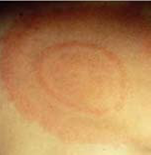 |
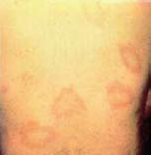 |
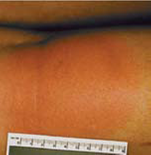 |
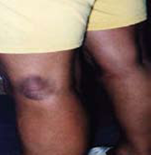 |
| Examples of Eyrthema Migrans Rash | |
How Is Lyme Disease Diagnosed?
If you think you have Lyme disease, you should see your health care provider immediately. Early diagnosis of Lyme disease should be made on the basis of symptoms and history of possible exposure to ticks. Blood tests may give false negative results if performed in the first month after the tick bite.
How Is Lyme Disease Treated?
Early treatment of Lyme disease involves antibiotics and almost always results in a full cure. However, the chances of a complete cure decrease if treatment is delayed.
In a small number of cases, Lyme disease can become a chronic condition. However, some patients have reported slow improvement and even an end to symptoms, months or even years after treatment.
How Can I Protect Against Ticks and Prevent Lyme Disease?
Deer ticks live in shady, moist areas at ground level. They will cling to tall grass, brush and shrubs, usually no more than 18-24 inches off the ground. They also live in lawns and gardens, especially at the edges of woods and around old stone walls.
Deer ticks cannot jump or fly, and do not drop onto passing people or animals. They get on humans and animals only by direct contact. Once a tick gets on the skin, it generally climbs upward until it reaches a protected area.
In tick-infested areas, your best protection is to avoid contact with soil, leaf litter and vegetation. However, if you garden, hike, camp, hunt, work or otherwise spend time in the outdoors, you can still protect yourself:
- Wear light-colored clothing with a tight weave to spot ticks easily.
- Wear enclosed shoes, long pants and a long-sleeved shirt. Tuck pant legs into socks or boots and shirt into pants.
- Check clothes and any exposed skin frequently for ticks while outdoors.
- Consider using insect repellent.
- Stay on cleared, well-traveled trails. Walk in the center of trails. Avoid dense woods and bushy areas.
- Avoid sitting directly on the ground or on stone walls.
- Keep long hair tied back, especially when gardening.
- Bathe or shower as soon as possible after going indoors (preferably within two hours) to wash off and more easily find ticks that may be on you.
- Do a final, full-body tick check at the end of the day (also check children and pets), and remove ticks promptly.
What Do Ticks Look Like?
The three most common ticks in New York State are the deer (black-legged) tick, the American dog tick and the lone star tick.
Only deer ticks can carry the bacterium that causes Lyme disease. They can also carry the germs that cause babesiosis and human granulocytic anaplasmosis. Young deer ticks, called nymphs, are brown and the size of poppy seeds. Adult female deer ticks are red and black, while males are black. Adult deer ticks are about the size of a sesame seed.
American dog ticks can carry the bacterium that causes Rocky Mountain spotted fever. Dog ticks are reddish-brown and larger than deer ticks. Deer and dog ticks are most active during the spring, early summer and fall.
Lone star ticks are becoming more common in New York State. They can carry the germ that causes human monocytic ehrlichiosis and are another rash illness that has been seen in over 20 other states. Adult female lone star ticks have a white dot on their back and are similar in size to deer ticks. They are most active from April through July.
Deer Ticks Actual Size |
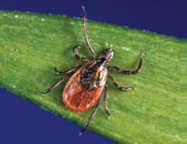 Female Deer Tick: CDC/ Michael L. Levin, Ph. D. |
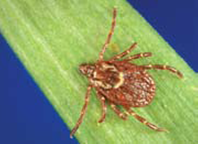 Female American Dog Tick: CDC/DVBID/Gary O. Maupin |
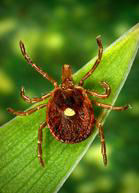 Female Lone Star Tick: CDC/ James Gathany; William Nicholson |
What About Insect Repellent?
Consider using EPA-registered insect repellents:
- DEET (N,N-diethyl-m-toluamide) can be applied to exposed skin. Products that contain 20% or more DEET can provide protection that lasts up to several hours. Use the lowest concentration that you will need for the amount of time you will be outdoors.
- Picaridin is a colorless, nearly odorless ingredient that can be applied to exposed skin in a range of 5 to 20% of the active ingredient.
- Permethrin: Clothes, shoes and camping gear can be treated or purchased pretreated with permethrin. Its protection can last through many washes. Never apply permethrin to skin.
The New York State Health Department recommends taking these precautions when using repellents that contain these active ingredients:
- Store out of the reach of children and read all instructions on the label before applying.
- Do NOT allow children to apply repellents themselves.
- Do NOT apply repellents directly to children. Apply to your own hands and then put it on the child.
- When applying repellents, avoid the child's face and hands.
- Do NOT apply repellents on skin damaged by sunburn, cuts, bruises or other conditions, such as psoriasis.
- Avoid prolonged and excessive use of repellents.
- Do NOT apply repellents in enclosed areas.
- Do NOT apply directly on your face.
- Do NOT apply near eyes, nose or mouth.
- Wash treated skin and clothing after returning indoors.
- If you believe you or a child is having an adverse reaction to a repellent, wash the treated area immediately and contact your local health care provider or local poison control center.
Also Consider These Important Facts:
- If you tuck pants into socks and shirts into pants, be aware that ticks will climb upward to hidden areas of the head and neck, so spot-check clothes frequently.
- Clothes can be sprayed with DEET or treated with permethrin. Follow label instructions carefully.
- Upon returning home, clothes can be put in a high temperature dryer for 20 minutes to kill any unseen ticks.
- Any contact with vegetation, even playing in the yard, can result in exposure to ticks. Frequent tick checks should be followed by a whole-body examination and tick removal each night. This is the single most effective method for prevention of Lyme disease.
How Can I Safely Remove a Tick?
If you DO find a tick attached to your skin, do not panic. Not all ticks are infected, and your risk of Lyme disease is greatly reduced if the tick is removed within the first 36 hours.
To remove a tick:
- Use a pair of pointed tweezers to grasp the tick by the head or mouth parts right where they enter the skin. DO NOT grasp the tick by the body.
- Pull firmly and steadily outward. DO NOT jerk or twist the tick.
- Place the tick in a small container of rubbing alcohol to kill it.
- Clean the bite wound with rubbing alcohol or hydrogen peroxide.
- Monitor the site of the bite for the next 30 days for the appearance of a rash. If you develop a rash or flu-like symptoms, contact your health care provider immediately. Although not routinely recommended, taking antibiotics within three days after a tick bite may be beneficial for some persons. This would apply to deer tick bites that occurred in areas where Lyme disease is common and there is evidence that the tick fed for more than one day. In cases like this you should discuss the possibilities with your doctor or health care provider.
 |
 |
|
| Tick Removal Graphic: CDC/Division of Viral and Rickettsial Diseases | ||
What Can I Do To Reduce Ticks In My Yard?
- Keep lawns mowed and edges trimmed.
- Clear brush, leaf litter and tall grass around the house, and at the edges of gardens and stone walls.
- Stack woodpiles neatly away from the house and preferably off the ground.
- In the fall, clear all leaf and garden litter, where ticks can live in the winter, out of your yard.
- Keep the ground under bird feeders clean so as not to attract small animals that can carry ticks into your yard.
- Locate children's swing sets and other play equipment in sunny, dry areas of the yard, away from the woods where ticks can be abundant.
- Using an approved insecticide once a year, in June, can significantly reduce tick numbers on a residential property.
For more information on Lyme disease, contact your local health department or refer to the NYS Department of Health web site at:
Follow us on:
- health.ny.gov
- facebook.com/NYSDOH
- twitter.com/HealthNYGov
- youtube.com/NYSDOH
State of New York Department of Health
Publication 2814
Revision 6/11